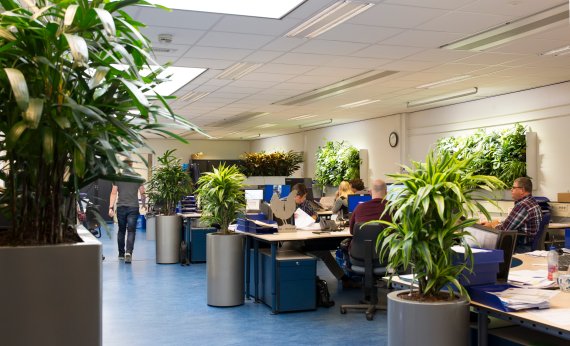text Roelof Kleis photo Marel Stork Poultry BV
You rarely see anywhere with so much greenery as Marel Stork’s office. Take your average workroom on campus. The Resource editors’ office for example. The author of this article has a pathetic Asparagus falcatus on his desk that is dying a lingering death due to a lack of water and an excess of coffee. Marel Stork’s place was not that green either until recently. Plants were put everywhere to turn the office into a trial location for research on the positive effects of plants on the indoor environment.
The alleged positive effects, because the evidence for this is slight despite all the claims and assumptions. ‘Greenery outdoors has a proven positive effect on people’s well-being,’ says project manager Tia Hermans of Wageningen Environmental Research. ‘But people aren’t outdoors much. They spend most of the time sitting inside. And there is little scientific evidence for the effects of greenery on the indoor climate. There are not many studies and some of the results are contradictory.’
Astronauts
You can find numerous lists on the Internet of plants that are said to improve the air quality in your home or office. They invariably refer to research by NASA as proof. The US space organization investigated whether plants on space stations could purify the air. They looked at the effect on compounds such as formaldehyde, benzene and trichloroethane.
Hermans’ study is not about space stations and astronauts; it focuses on the working environment of mere earthlings. Do we benefit from greenery in the office? Do plants make us healthier and harder working? That is the issue at stake in this project, which Hermans is carrying out for the Horticulture and Propagation Materials Top Sector. The project is with eight other partners, including the garden and indoor plant company Donkergroen and nature organization IVN. ‘We are investigating the effects of greenery on people’s well-being, air quality and the interaction between the two. The ultimate aim is to develop revenue models for companies for recouping the costs. If a firm invests in greenery, what does it get in return in terms of less sickness absence, increased productivity or lower energy consumption? Horticultural companies can use that knowledge to market their products and services.’
Gnats
For the past six months, Marel Stork’s office, Amsterdam Basel and seven care institutions spread across the Netherlands have been stuffed full of plants. Coca Cola was also a participant but the trial there had to stop after six months. ‘Because of the dark-winged fungus gnats,’ says Hermans. ‘The gnats were a real problem. It seems the soil around the plants was full of the eggs of these gnats. Apparently they’re a major pest in greenhouse cultivation.’
Setbacks such as the Coca Cola episode are inherent in studies on location like this. It was a real challenge finding participants for the experiment anyway, says Hermans. ‘Companies find it too expensive or too much of a hassle, or they think the plants are unattractive or don’t like the beasties. Some want to see the revenue model first, whereas that’s precisely what the research is for!’ WUR’s own Facilities & Services also decided not to take part.

Coca Cola wanted the Anthurium because the red in the flowers matches their logo
Tia Hermans from Wageningen Environmental Research
Red flowers
The three companies and seven care institutions that are taking part all have a collection of plants that has been carefully chosen to suit the conditions. The expertise of the Leiden company Fytagoras was used for this. They can calculate how much leaf surface is needed for a required increase in the air humidity based on the dimensions of the room and the temperature. This was used to make a selection of plants from a range of 85 species for which the effects are known. The participants have a say in the selection too. Hermans: ‘For example, Coca Cola wanted the Anthurium because the red in the flowers matches their logo. That plant is popular in care institutions too. Older people remember the plant from days gone by.’
The experiment also involves employees completing a detailed online questionnaire every three months, with questions about their well-being, health and ‘emotional status’. And loads of measurements are carried out too. Sensitive sensors continuously measure the temperature, air humidity and concentrations of CO2 and volatile organic hydrocarbons in the air. The data is sent directly to a central computer at Fytagoras. Baseline measurements were made prior to the intervention, of course, and there is a control in the form of a similar office without plants.
Green offices everywhere
The question is whether there is a quantifiable effect. The first results do suggest this, says Hermans. ‘These are the measurements at Coca Cola. Plants appear to increase the air humidity. And that is good news. People in offices and care institutions often complain about dry eyes and low humidity. But we still need to analyse everything and relate it to the conditions outdoors.’
So it is possible that all offices will be full of greenery soon. Hermans would be fine with that. ‘I would be really happy if our study showed that plants have such a big effect that an employer would be a fool not to make that investment. To have a green working environment as the new norm.’

